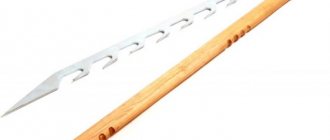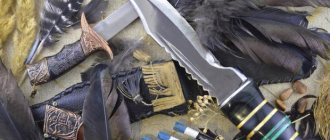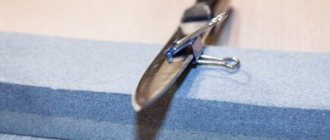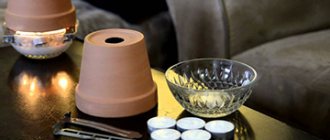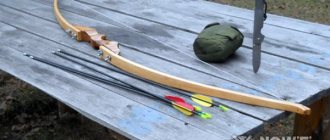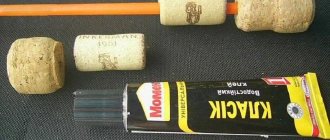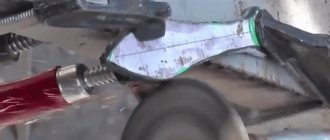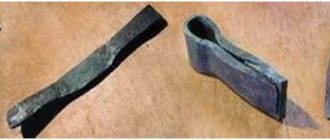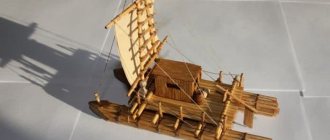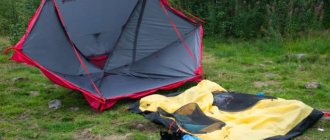Application tactics
There are no special tricks when fishing with a lift. If an angler knows well the features of the bottom of a reservoir, this significantly increases the chances of a big catch. You should choose flat areas and places with a slight slope:
- not far from some snag;
- near a stone;
- near thickets of aquatic vegetation;
- under a wall of reeds;
- at the bottom of the pit.
After this, you should periodically lift the tackle and check for the presence of a catch. Such fishing will be successful both during the day and at night, and sometimes at night the catches can be greater than during the day. When using larger lifts, there is a way to simplify the process of pulling the net out of the water: you need to attach another rope to the end of the pole, where the spider itself is already tied, and pull the tackle out by it, having first found a reliable support for the pole on the shore.
Photo 2. Lowering the spider into the water.
In the case of a stationary lift, it is even simpler; there is no need to select a fishing point. Such spiders are large in size, and as a result, they are installed motionless and equipped with a mechanism that facilitates the lifting of a heavy net with a catch. Sometimes a sheet of metal painted white is lowered to the bottom of the lift under the structure and secured there, most often simply by rolling the corners with massive stones. This improvement makes it possible to assess the presence of catch in the net, although particularly wary fish may be scared off by a very bright and prominent area of the bottom.
Photo 3. “Trophies” in the grid.
Features of fishing with a spider
There are other ways to collect a “spider” for fishing; among the fishing methods, “iron fishing” stands out well. The whole problem with the gear is that fishing on rivers with a “spider” is done blindly; the fisherman pulls the gear without knowing whether there is any catch. Even at shallow depths, the water is often so murky that visibility is practically zero.
Read more
What is a split shot?
It is worth using bait if you plan to catch more small fish
The essence of using iron is to install a painted metal sheet, mostly white, on the bottom. The lift is installed directly on the iron sheet. As a large fish approaches, its silhouette will begin to contrast with the white color, and the fisherman will be able to hook in time.
If you plan to catch more small fish, you should use bait. Having thrown the bait mixture, wait a little while for medium-sized crucian carp and roach to swim to the spot, and then sharply remove the trap from the water.
Making your own spider
A DIY fishing spider can be made from different materials and in slightly different ways. It all depends on what the fisherman has on hand and what size net he plans to create. The simplest solution if you have a welding machine in cases where you need a small lift for catching live bait is to simply weld two metal rods in the middle, and weld a ring there for attaching the rope.
This is interesting: Decoy for wood grouse
After this, you should bend the ends of the rods and attach a piece of net of suitable size to them so that it only sag slightly. The size of the mesh and the thickness of the fishing line from which the lift is made are selected according to the expected catch. A factory-made small spider for catching live bait can also be bought in fishing stores.
Photo 4. The crosspiece is enlarged.
This tackle can also have a collapsible design. To do this, you will need a crosspiece, and the same metal rods, the length of which must be selected based on the desired dimensions of the future lift (but if the sides are more than a meter long, this will already be considered poaching gear). The spider's legs can not only be removed from the crosspiece, but they themselves can have a collapsible design, thereby increasing the compactness when disassembled.
There are two ways to implement this.
- The first - thread, provides a strong connection, but there is also a drawback. If clogged, problems may arise with assembling and disassembling the gear.
- A more reliable option is to use pieces of pipe into which the rod fits without a gap - a similar connection method is used in rods of a plug design, which means you don’t have to worry about reliability. Part of the tube is welded to the spider's leg, while the other part remains open and is easier to clean due to the lack of threads.
The ability to disassemble the lift is very important not only when traveling to a remote body of water, but also if your favorite fishing spots are located in hard-to-reach areas of a river or pond.
When making a spider, it is not even necessary to use metal parts. If the net is small, then flexible wooden rods are sufficient, but when such a fishing lift gets into a more or less serious catch, this may result in the equipment breaking. And in order to catch live bait, even such an unreliable design is enough.
How to make a spider for fishing and what types exist
Spider fishing is not clearly perceived by fishermen and, given some parameters of the device, is considered a purely poaching method of catching fish, which has nothing in common with sport fishing. But in some cases, fishing tackle is permitted for use under legitimate conditions and is an excellent help for anglers hunting for predatory fish and constantly in need of live bait. Such a tool can be purchased without any problems in a network of fishing stores and, equipped with a lightweight pole and a ten-meter piece of strong, small-diameter rope, can be used to ensure fishing with fresh live bait.
The article presented to the reader will help to understand the types of spiders for fishing, understand its operating principle and how to make it yourself. The fisherman will be given recommendations for choosing promising fishing spots with this tool, and the nuances of the geometric characteristics and devices permitted for its legal use will be discussed.
A fishing spider, or also a product called a lift in the fishing community, is a fishing tool consisting of a square piece of mesh stretched between rigid metal rods of a frame, the upper part of which is connected to a specially designed device for this purpose, called a cross. Depending on the purpose of the spiders, they can have mesh fabrics of different sizes, which in turn can have different cell sizes. Spider fishing is done blind.
Large spiders
Fishermen (albeit more likely poachers) in quiet places far from busy paths use lifts so large that a person is unable to pull such a structure ashore even empty, not to mention the additional weight of fish and algae caught in the net. In such situations, they resort to the use of mechanical improvements that make it easier to pull out the net, and the spider itself is made with a much greater margin of safety. If aluminum could still be used for a small lift, then only iron is suitable. The rope may also not be strong enough, as a result of which it is replaced with a steel cable. A special roller is usually installed at the end of the poles of such huge spiders, and they are lifted using a winch. The strength and size of the structure make it possible to catch trophy specimens of both peaceful and predatory fish, which poachers take advantage of, especially during the spawning period.
Design Features
A fishing spider is a simple design both to use and to make independently. It consists of metal rods fixed in a cross and a net stretched between their ends, bending during the fishing process and holding the fish inside. There are also options with small side walls, also mesh, that prevent small fish from trying to escape.
For fishing from bridges and piers, a rope is simply tied to the crosspiece. If the spider is used from the shore, then in addition for normal operation of the tackle you will need a pole of the appropriate length to ensure delivery of the lift to the fishing point remote from the shore.
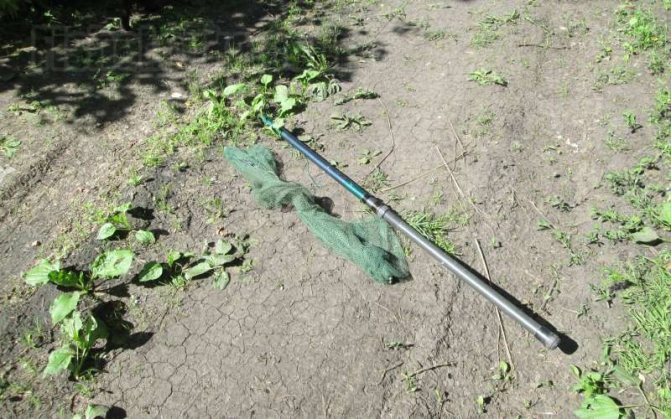
Photo 1. Spider and black when folded.
Fishing with a spider does not involve visual monitoring or any indicators of the presence of fish; the lift is simply checked at certain intervals, depending on the characteristics of the reservoir, the fish that are planned to be caught, and not least on the personal preferences of the angler. Sometimes bait is also used. It is thrown into the net when it is already installed at the bottom, but more often it is done without feeding.
Important! If the depth at the fishing spot is shallow and the bottom is light (for example, sandy), then you can use polarized glasses - it will be easier to see the fish without the glare of the sun.
Gear device
A fishing spider, or, as it is also called, a lift, is a square mesh stretched using a metal frame. It consists of the following elements:
- Cross. This is the top and base of the spider. It consists of two hollow tubes welded perpendicularly, to which a rope loop is attached on top.
- Four rods. These elements hold the entire structure in working position. Their lower ends are attached to the corners of the canvas, and the upper ends are inserted into the cross tubes.
- Net. Depending on the purpose of the tackle, it can have very different side lengths and cell sizes. It is secured using a sliding method on a square rope base stretched between the edges of the rods. This connection method allows the tackle to bend better under the resistance of the water at the right moment, creating a pocket for the fish being lifted.
- Rope. It should have a length depending on the casting location, a small thickness to minimize resistance, but at the same time be very tensile strength, since when rising it will need to take on the resistance of not only the fish, but also the water.
- Pole. Its length also directly depends on the fishing conditions. When choosing a pole, it is important to combine high strength with relative lightness, since you will have to hold it for quite a long time, and the large weight will cause inconvenience, including when lifting.
This is interesting: Poisonous plants of the Krasnodar Territory and Saratov region
Despite the apparent external complexity, the lift is very simple. Even a child can understand its design and operation.
With your own hands
The design of the spider is quite simple. To make the tackle, first of all you will need a strong crosspiece into which the arcs will be inserted. The more powerful it is, the less shaky the structure itself will be. Some fishermen make arcs from small-diameter plastic pipes. You can use metal rods. And, of course, a fishing net with not too large cells.
The arcs must be equal in length. They must be inserted into the crosspiece (it is advisable to make a collapsible structure). A strong eye is made on the crosspiece into which the pole will be inserted. The net is attached to the ends of the arcs using fasteners (you can tighten ordinary bolts of appropriate sizes) and is tensioned. A block can be attached to the pole through which the lift cord will pass. That's all: you can go fishing.
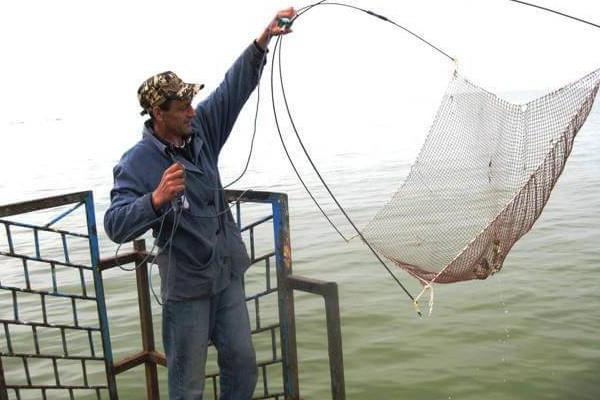
Types of lifts
There are several basic types of spiders designed to catch different fish in different conditions. Their size and design can vary quite a lot, which is why before purchasing it is necessary to understand for what purposes it will be used. Existing gear can be divided into several types:
Malyavochnitsa
This is the most common version of the lift, intended mainly for catching live bait. It is equipped with a classic one-piece cross, as well as a small mesh. Some models also have low sides designed to prevent the fish from rolling off the tackle when being lifted out of the water. Small fish are often unable to properly tension the canvas, which is why they can spill out of it along with the water, especially with a small cell size.
The pole for a small fish usually does not exceed three to four meters in length, since fishing is usually carried out near the shore. Despite its small dimensions, using such a spider is not much easier than a larger one, since the small mesh creates a fairly high water resistance when lifting.
Winter
The size of this spider is also small, but it has a number of differences from the classic little spider. Firstly, its rods are rigidly fixed in the upper grooves to prevent them from flying out under water. And secondly, the crosspiece of such a lift is equipped with a special spring mechanism designed for fishing from ice in winter. It allows you to fold the base rods together, reducing the dimensions of the lift several times.
The mechanism of the winter spider is designed in such a way that the cross holds it in an unfolded state when moving in the water column and folds when it touches the hole; this allows you not to make a hole in the ice, which is not always possible, but to catch fish with a spider using a regular ice drill. The caught live bait, at the moment of folding the rods, ends up in a kind of bag from which it does not have time to get out.
Big
A full-fledged spider differs from a small spider only in size: its sides can reach several meters, and the mesh can be quite large. Medium-sized lifts are also lifted using poles, while for the largest ones they usually use winches, since it is almost impossible to work effectively with them by hand.
Such spiders may have a tightly stretched mesh or with a slight sag, forming a kind of bag, like in a landing net. Currently, there is no consensus among anglers about which design is preferable for catching large fish.
How to fish
Catching fish with this gear is technically very simple, but requires a certain amount of physical training from the fisherman. To do this, you need to choose a place with no or moderate current, assemble the lift and, using a pole, throw it into the water so that it lies in a net on the bottom. Next, fishing is carried out blindly: the structure rises with a sharp movement, capturing all the fish located above it at that moment. It is important to do this quickly enough so that the prey does not have time to swim out of the net while moving.
This is interesting: How to knit a double fishing clinch knot: diagram
In addition, when using a spider, there are seasonal characteristics. When fishing in spring, for example, especially at the beginning, this fishing tackle gives a head start to most others. During the period of rising water levels, when a significant part of the fish practically does not react to bait, the spider can save the fisherman from an empty cage. Spring fishing is usually done from the shore, as fish, especially small ones, begin to move out of the holes into areas with warmer water. During this period, you can also use bait to attract prey.
In summer, fishing for spiders is made easier by the fact that after the turbidity settles, there is already a chance to see fish in the water column. However, during this period, prey tries to stay at depth, which is why it is best to choose small river beds for fishing or fish in deep places from bridges, piers and other similar structures hanging over the water.
In autumn, the activity of fish increases, it begins to move around the reservoir, which is why the fisherman needs to lift the tackle more often. At the same time, you can fish quite successfully almost anywhere.
For winter fishing, you can use both a special and a classic spider. In the first case, the tackle is lowered into the hole, which allows you to change the fishing location quite often in search of a more successful option. When fishing with a conventional lift, it is necessary to cut an ice hole, which is why it will not be possible to effectively explore the reservoir with it, especially if the ice is already about a meter thick. It needs to be raised less frequently in winter due to low fish activity.
Types of fishing lifts
In semi-flowing reservoirs with strong currents, a spider with a rigid base is used. A net with increased sagging is placed on a round or square frame, which allows it not to be overloaded when lifting. The device rests on the bottom with one edge.
Ponds with active currents also use a spider fishing tackle known as a parachute. The configuration of the lift resembles a net, has a large net slack, and is equipped with a frame made of reinforcement or metal rods. A thick rope is fixed to the base, consisting of four slings of different lengths, the angle of inclination of the structure is 45°. The diameter of the network cells is 50−90 mm. The device is designed for large fish. The optimal place for fishing with such gear are bridges, under which the movement of water is maximum. One end of the rope is fixed to the bridge railing for insurance, and the other end is held by the spider in the pond.
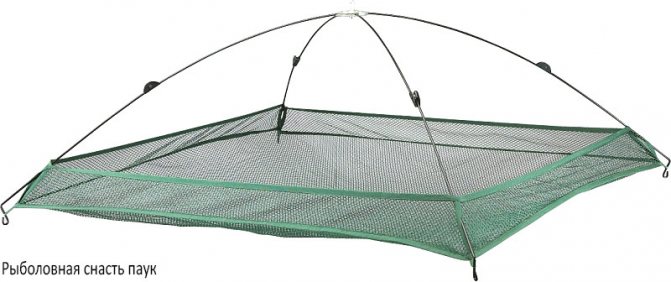
Among homemade models, the cradle is popular. It is assembled from metal (galvanized) mesh measuring 500/500 or 1500/1500 mm. The cross section of the cells is 5−20 mm. The net is slightly bent, attached to the four corners of the rods, tied together, and fixed on ropes. Fishing with a spider cradle is done by regular casting or pulling it out of the water at an angle of 45°.
Manufacturing
Making a spider for fishing with your own hands is not very easy, but if you have certain skills, it is quite possible. To do this you will need:
- Net. You can weave a fabric of the required size yourself, however, if you do not have such skills, it is definitely better to buy it. Along the edges it should be placed on a thick fishing line.
- A durable metal tube with an internal diameter of about 7-10 millimeters and a length of about 60 centimeters.
- Four metal rods that fit tightly into the tube.
- Metal ring with a diameter of 2-3 centimeters.
- A piece of rope 4-9 meters long.
- Durable pole.
Drawings of finished spiders can be found on the Internet, but in most cases their sizes are determined depending on the desire of the fisherman and the available material.
To make a classic lift you need:
- Boil them in the shape of a cross.
- Weld a ring in the top center to secure the rope.
- At the lower ends of the rods, form fasteners for the mesh - they can be bent or sharpened with a hacksaw.
- Wrap the ends with electrical tape, and then tightly attach the corners of the fishing line or thread on which the mesh is attached to them.
- Insert the upper edges of the rods into the crosspiece. They must bend, providing elasticity to the structure. If it is too difficult to insert them or the mesh is too tight, you can shorten the rods to the optimal state, but you must make sure that they are all the same length.
- Tie the rope to the fastening ring.
- Tie the other end to the edge of the pole.
As you can see, if you have the materials, making a lift is quite simple - the only difficulty is welding the cross. When working with canvas, the main thing is its even fit on the frame.
Required materials and tools
If the tackle is assembled at home, where there is access to various materials, resources and tools, all the work will take a little time and lead to minimal effort. It is better to use durable but lightweight materials as the basis of the tackle; this will simplify the process of removing the “spider” from the water.
To implement the classic “spider” drawings for fishing you will need:
- aluminum tubes, wooden poles as a pole. Oval handles are more convenient to use, since excess force is removed from the hand in the process of removing the gear. For comfort and strength, the ideal choice is a stick 4-5 cm in diameter. The length will have to be chosen according to the conditions of use, usually up to 3-4 m;
Read more
How to catch bream with a ring from a boat?
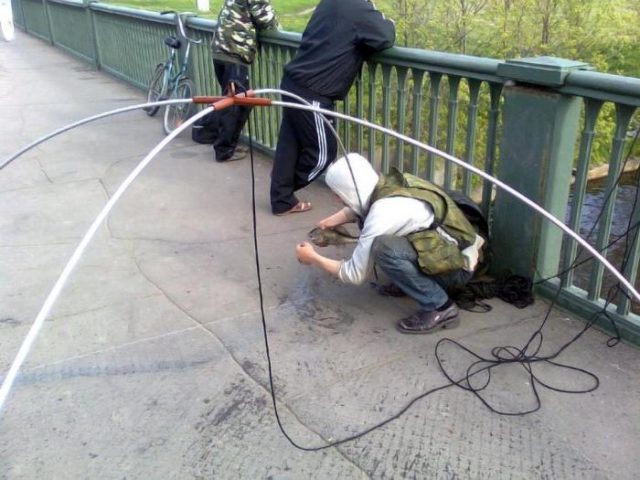
Durable but lightweight materials are best used as the basis of the tackle
- thin aluminum tubes for making the cross. Their diameter should fit tightly to the arcs;
- aluminum arches can be replaced with flexible and durable wood. The best material available in nature is strong acacia branches; they bend well and are resistant to cracking. It is better to take 1-1.8 cm in diameter, similar to the size of the cross. It is better to select the length taking into account the depth and size of the mesh;
- spider net for fishing made of nylon or fishing line. Fishermen prefer fishing line due to its durability, ability to hold shape and availability;
- rope, located between the cross and the spider stick;
- hammer;
- welding installation.
In nature, analogues of the listed materials are:
- woodworking tools;
- wooden base made of strong branches as a handle;
- a pair of long and strong branches as arches that can be even;
- net or any material from which a net can actually be made using available means.
